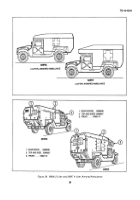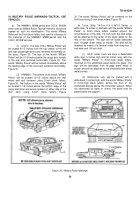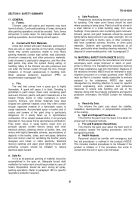TB-43-0209 - Page 43 of 406
TB 43-0209
31. TIPS ON PAINTING
Certain basic precautions are applicable to paint,
varnish, enamel, and lacquer. The following should be
observed at all times:
a.
Do not paint over an unclean surface. Be sure all
dirt, rust, scale, etc., are removed.
b
.
Do not fail to stir paint thoroughly.
c.
Do not mix one paint with another unless
instructed to do so.
d.
Do not fail to follow instructions that appear on
containers, particularly those concerning safety, the
addition of thinner, and the application instructions.
e.
Do not apply paint or varnish unless the drying
conditions are satisfactory.
f.
Do not paint in wet or extremely cold weather,
below 50’ F (10’ C).
g.
Do not apply abnormally heavy coats.
h
.
Do not add too much thinner.
i
.
Do not use paint buckets, cans, paint rollers,
spray guns, or brushes which are not clean.
j
.
Do not apply cold paints on varnishes.
k
.
Do not leave old paint and oil-soaked cloths
laying around in the paint shop; they are a fire hazard.
l
.
Do not fail to clean brushes, paint rollers, and
spray guns immediately after using.
m
. Do not smoke when painting. Do not smoke near
paint storage areas or paint booths.
n.
Do not release the tops of pressure-feed
material containers before releasing the air pressure.
o.
Do not use electrical connections that show any
inclination to becoming loose.
p
.
Do not pour paint out of a container in a manner
that obscures the label.
q
.
Do not fail to strain paint before using, if
required.
CARC paints cannot be strained, however.
r.
Do not fail to remove all traces of wax from
surfaces where paint or varnish is to be used.
s.
Do
not
paint
without
proper
respiratory
equipment and ventilation.
t.
Do not waste paint by spraying beyond the item
being coated.
u.
Do not paint over a moist or wet surface.
v.
Do not paint between the ground strap and hull
of tanks.
w
. Do not paint on operator-instruction plates.
32. TIPS ON PAINTING WITH CARC
The following precautions should be observed, in
addition to those listed in paragraph 31 above, when
applying Chemical Agent Resistant Coatings (CARC):
a
.
Spray ’nes for epoxy applications should not be
used with polyurethane coatings without complete
flushing or cleaning wit] solvents.
b
.
Test for cleanliness when applying CARC with
the red litmus or war-r break test.
c
.
Remem3er to notify the local safety office and
preventive medicine support activity prior to initial CARC
painting. This also applies to all spray painting
operations, regardless of the material used.
d.
Do not use CARC for items like manifolds and
mufflers that exceed 400’ F. Do not use CARC on
rubber, lacquer coatings, or vinyl.
e.
Use silicon rubber (impervious), not cloth, gloves
when applying CARC.
f
.
Only DS/GS General Support and Depot level
personnel are authorized complete painting and
repainting of components with topcoats and primers. Unit
and DS/GS Direct Support level personnel are only
pemitted to use topcoats and primers for touchup efforts.
g.
When using CARC, mix only the amount needed
to do the job (i.e. don’t open a large container for a small
job) because unused CARC must be disposed of and
cannot be stored.
h
.
Epoxy-polyamide coatings build up thickness
quickly.
Thick films are detrimental for good adhesion. Do not
apply CARC beyond its thickness tolerances.
33. MARKINGS TO BE APPLIED TO EQUIPMENT
After the equipment has been pattern painted, only
the following markings are to be applied:
a.
Unit identification.
38
Back to Top




















